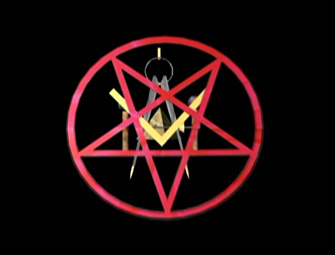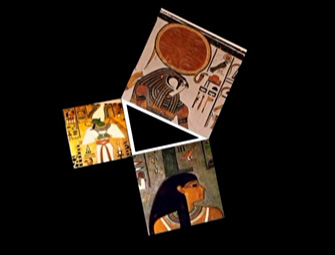|
Riddles in Stone
A review in three parts
�Documentaries are meant to document. This one claims to document the street plan of Washington, DC and uncover its secret meaning. It doesn't. What in fact it does document is the unverified opinions and assertions of a narrow group of stakeholders with an interest in promoting one interpretation of the street plan.
|
PRESENTED AS a documentary asking hard hitting questions, this video rarely supplies documentation, presents opinions rather than answerable questions and, by failing to provide a forum for a reasoned rebuttal, doesn't allow the questions to be answered. The introduction on the DVD case sets the tone by labeling the freemasons as "apologists" and the conspiracy theorists as "leading researchers."
The agenda
|
 Visually identifying the pentagram with the square and compasses. [00:19:00]
Visually identifying the pentagram with the square and compasses. [00:19:00]
|
The agenda driving this video is made obvious in the first few minutes when the claim is made by Jim Alison: "Clearly a lot of the designers and architects of Washington, DC were masons." Closely following this claim is the equally unproven implication that "Masons secretly worship Baal." No proof. No documentation. No opportunity for rebuttal. The viewer has to watch almost two hours of spurious and specious argument and deceptive images linking all manner of witchcraft and magic to Freemasonry before the other shoe drops, with the accusation: "In the pantheon of pagan gods Mithras occupies the place of the masonic Christ." While these claims are reiterated frequently, they are never demonstrated to be fact.
It is telling that in a documentary about architecture, sculpture and history, not a single architect, sculptor, historian or academic was interviewed. While much is made of the influence of the Kabbalah, no Talmudic scholar was interviewed. Those interviewed are, in the main, promoters of opinions with books and videos of their own to sell.
The fifteen featured speakers can be loosely catagorized as two died-in-the-wool Christian anti-masons, nine proponents of various new-age beliefs, one critic of those new-age beliefs, a British walking-tour guide with nothing to add to the discussion, and two freemas���ons who are allowed about sixteen of the 170 minutes to deny the accusations, but no time to actually rebut them. There is also a special appearance by Benjamin Creme, who claims to communicate with "Maitreya", the soon-to-return Christ.
The occult and Freemasonry
Although Obadiah Harris defines occult as meaning hidden or obscure, this is disingenuous. Yes, the Latin root occultus means hidden from view, but in the popular mind the word occult pertains to magic, astrology, or any system claiming use or knowledge of secret or supernatural powers or agencies—often evil and probably satanic. Presenting Harris's definition, as proper as it is, allows the subsequent labelling of all manner of unrelated esoteric teachings or societies as "the occult". Esoteric refers to inner or private knowledge and better describes much of what is labelled the occult. Note the use of the definite article, "the", which creates the impression of a group, without defining it. Citing the Star of David as "one of the most dominant symbols in the occult" is equally disingenuous. This is verbal shorthand identifying the State of Israel with numerous antisemitic conspiracy theories.
Although the point is briefly made that symbols have many meanings, the focus of the video is to narrow the interpretations to as few as possible, and those as negative as possible. The narrator intones significantly: "Removing the base of the triangles [of the Star of David], one can see the outline for the square and compasses of Freemasonry." But no justification is given as to why this might be significant. The narrator claims: "It is a fact that the unfinished or broken pentagram is a recognized symbol in the occult." But the fact that Manly P. Hall stands alone in this claim is not mentioned. It is an historical fact that the pentagram has had many meanings in esoteric studies and practice, but there is no evidence to suggest that a broken or incomplete pentagram has any meaning other than a symbol for shoddy workmanship. When the narrator claims: "For many researchers, the presence of the all-seeing eye floating above an unfinished pyramid stands as clear proof of the Illuminati at work in America," it would be nice to be told what researchers and on what authority they come to this conclusion.
|
 Visually identifying a geometric formula with pagan worship.
Visually identifying a geometric formula with pagan worship.
|
Much is made of the masonic membership of a few high-profile authors or practitioners of occult, esoteric or fringe religious or philosophical beliefs. Notorious late-nineteenth century occultist, Aleister Crowley is claimed to be a freemason but no mention is made that regular Freemasonry never recognized his claim. The claim is made that "many masons call Manly P. Hall Freemasonry's greatest philosopher" but how many is "many"? And how many others might argue the point? And what is the relevance to something that happened a hundred years before he put pen to paper?
It's called an ex post facto argument. The street plan was designed in 1792. The opinions, beliefs or claims of anyone after that time are not relevent to determining motivation or intent. It is only the facts of the time that may have infused those opinions, beliefs or claims that are relevent. And they are not presented here.
The all-seeing eye is repeatedly identified as masonic and representing the Egyptian god Horus. Schnoebelen claims: "Masons teach that there is a five pointed star under the altar but don't tell you it represents Sirius which is regarded as a satanic figure." Still claims : "masons refer to the one-point down pentagram as referring to evil freemasonry." Alison claims: "thirteen courses of masonry corresponds to the thirteen steps on the pyramid." And Decker claims: "Pike was literally a luciferian... the centre core of Freemasonry." Claims are piled on claims, but no evidence is shown.
When it is noted that "according to masonic historians Enoch was later known as Hermes to the Greeks and Mercury to the Romans," this singles out masonic historians from just about anyone who has read the classic literature of the Greeks and Romans. They're freemasons and now they're identified with pagan religions, which is a rhetorical shorthand for anti-Christian. But this is guilt by association, and a very tenuous association at that. What Schnoebelen, Still, Alison and Decker share is an inability to accept that Freemasonry and freemasons may not share their narrow, limited interpretation of symbols. It is easier to visually associate Pythagorus with images of Joseph Stalin and Adolf Hitler than it is to consider that symbols can represent many different, perhaps contradictory, ideas.
What's it all mean?
A few pretty pictures and one unintentionally entertaining pronunciation of Goethe as "goatie" are about all this production has to offer. Claims and accusations are piled high but no evidence is provided for any of it. A narrative of innuendo and implication moves the viewer to overlook the complete absence of causality, logic or connection between unrelated facts and unsubstantiated opinions. William Schnoebelen's vague bromide, "Where there's smoke there's fire" substitutes for actual evidence. Repeated assertion substitutes for proof.
A documentary hidden with a documentary
Hidden within this video is another documentary composed of visual elements and key words creating a narrative story arc that will be easily understood by the intended audience, an audience of Christian end-time millennialists who believe that prophesies of the Armageddon of John's Revelation are revealed in current events.
Playing to a Christian vs "occultist" vision of America, the use of understood "code" images and words—Enochian, rosicrucian, secret societies, hermeticism, Theosophy, Dr. John Dee, Sir Francis Bacon, the Star of David, pagan religions, New World Order, one world government, United Nations—all reference a community of thought that views everything of this nature as anti-Christian and satanic. It also plays to a community that accepts the existence of demons and spirits. When Dr. John Dee is said to have "made contact with angelic beings", this is accepted at face value. When Éliphas Lévi is described as "the most powerful sorcerer of the nineteenth century" no literary licence is intended. When the alleged Baphomet of the Knights Templar is described as a "three headed diety or as a skull, or as a goat headed being," Schnoebelen comments. "I think this is probably true."
The last ten minutes, a mini-documentary on Benjamin Creme—a man who claims to be in etheric communication with "Maitreya", the returning Christ—has nothing to do with either Freemasonry or Washington DC. But it does serve to distract the viewer from the fact that none of the "hard-hitting questions" have been asked, much less answered. It also completes the subtext narrative: Creme believes that "Maitreya" represents the second coming of Christ. Dispensational Christians view Creme's Maitreya as the Anti-Christ. The last word goes to Creme: "Maitreya spoke to me himself. He will face humanity with a choice, create justice in the world and build the most beautiful civilization this earth has ever seen, or perish utterly. That's the choice."
This is not a documentary, this is an exercise in fear mongering.
|
Riddles in Stone The Secret Architecture of Washington D.C. Secret Mysteries of America's Beginnings Volume II. An Antiquities Research Films Production. Executive Producer David E. Bay, Associate Producers, Jim Hedgepath, Mary Bay, Meg A. Pinto, Clark Aliano. Written, direc���ted and produced by Christian J. Pinto. Research compiled by David E. Bay, Glenn Beckham, Tony Noel, Mike Noe, Christian J. Pinto. 2006. Cf. Trevor W. McKeown, Interview Notes 29 July 2006.
|
|
|